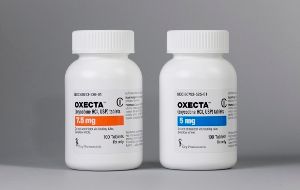New FDA Actions: King Pharmaceuticals, Inc's Oxecta
The FDA approved a new formulation of immediate-release oxycodone. Oxecta (oxycodone HCI), for the treatment of acute and chronic moderate to severe pain.
The FDA approved a new formulation of immediate-release oxycodone. Oxecta (oxycodone HCI), for the treatment of acute and chronic moderate to severe pain.

The FDA has approved Oxecta (oxycodone HCl) from King Pharmaceuticals, Inc, a wholly owned subsidiary of Pfizer Inc, as a new formulation of immediaterelease oxycodone that utilizes technology designed to discourage abuse.1
Oxecta uses Acura Pharmaceuticals, Inc’s patented Aversion Technology, which incorporates commonly used active and inactive pharmaceutical ingredients for oral drug products to allow for relief of pain while deterring common methods of abuse. Examples of Aversion Technology include prevention of intravenous abuse by causing the medication to gel when crushed and exposed to solvent, determent of abuse via snorting by causing irritation to the nasal mucosa, and determent of excess ingestion by incorporating niacin to result in an uncomfortable reaction.2
Oxecta is indicated for the management of acute and chronic moderate to severe pain where the use of an opioid analgesic is appropriate. It is available as a 5- and 7.5-mg tablet.3
Pharmacology and Pharmacokinetics
Oxecta is a pure opioid agonist and is relatively selective for the mu receptor. Its main therapeutic action is analgesia, and like all pure opioid agonists, there is no ceiling to its analgesic effect.
The peak plasma concentrations of Oxecta occur approximately 1.2 to 1.4 hours after the dose with an average terminal half-life between 3 and 4 hours. The times to peak exposure and terminal elimination half-life of Oxecta are not different from those of traditional formulations of immediate-release oxycodone tablets. Gender does not appear to affect the pharmacokinetics of Oxecta.3
Dosing and Administration
The dose of Oxecta should be individualized for each patient. Opiate-naïve patients can begin treatment with 5 to 15 mg every 4 to 6 hours as needed for pain. Oxecta should be taken with enough water to ensure that each tablet is completely swallowed immediately after placing it in the mouth. The tablets must be swallowed whole and cannot be crushed or dissolved. Oxecta should not be used via nasogastric, gastric, or other feeding tubes, as it may cause the tubes to become obstructed. If discontinuation of treatment is required, the dose of Oxecta should be gradually tapered to prevent withdrawal symptoms.3
Clinical Trials
Oxycodone was initially granted FDA approval in 1982. Oxecta has been determined to be bioequivalent to other commercially available formulations of immediate-release oxycodone when taken in the fasted state. Although its pharmacokinetic properties differ when taken with a highfat meal, these differences are not considered to be clinically significant.3
The FDA has required a post-approval epidemiologic study to evaluate the impact of Oxecta in reducing the abuse and misuse of opioids; however, these data are not currently available.2
Contraindications, Warnings, and Precautions
The use of Oxecta is contraindicated in patients with a known hypersensitivity to oxycodone, oxycodone salts, or any components of Oxecta, or in any situation in which opioids are contraindicated. Its use is contraindicated in patients with respiratory depression, paralytic ileus, or acute or severe bronchial asthma or hypercarbia.
The risk of respiratory depression is increased in elderly or debilitated patients or patients with hypoxia, hypercapnia, or upper airway obstruction. Oxecta is a Schedule II controlled substance. The depressive central nervous system (CNS) effects of Oxecta are additive when used with alcohol, other opioids, or illicit drugs. Intracranial pressure may be exaggerated in the presence of head injury or intracranial lesions. Oxecta may exert a hypotensive effect. Its use should be avoided in patients with gastrointestinal obstruction. Use cautiously in patients with biliary tract disease.
Oxecta may impair mental and/or physical abilities; caution is advised regarding potentially hazardous activities, such as driving a car or operating heavy machinery. Use caution and reduce doses in patients with severe renal or hepatic impairment, Addison’s disease, hypothyroidism, prostatic hypertrophy, or urethral stricture, or in elderly or debilitated patients. Use caution in patients who are pregnant. Oxecta should not be used during labor or breast-feeding or in patients younger than 18 years.
Concomitant use of inhibitors of cytochrome P450 3A4 may lead to increased levels of Oxecta. Other drugs that interact with Oxecta include CNS depressants, muscle relaxants, mixed agonist/antagonist analgesics, monoamine oxidase inhibitors, and anticholinergic medications.
The most common adverse reactions are nausea, constipation, vomiting, headache, pruritus, insomnia, dizziness, asthenia, and somnolence.3
Dr. Holmberg is a pharmacist who resides in Phoenix, Arizona.
References
1. Pfizer and Acura announce FDA approval of Oxecta. http://acurapharm.com/investors/press-releases/. Accessed February 2012.
2. Acura Pharmaceuticals, Inc. Aversion Technology. http://acurapharm.com/research-development/aversion-technology/. Accessed February 2012.
3. Oxecta complete prescribing information. http://labeling.pfizer.com/ShowLabeling.aspx?id=620. Accessed February 2012.

